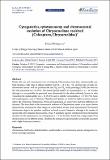Por favor, use este identificador para citar o enlazar a este item:
http://hdl.handle.net/10261/99862COMPARTIR / EXPORTAR:
 SHARE SHARE
 CORE
BASE CORE
BASE
|
|
| Visualizar otros formatos: MARC | Dublin Core | RDF | ORE | MODS | METS | DIDL | DATACITE | |

| Título: | Cytogenetics, cytotaxonomy and chromosomal evolution of Chrysomelinae revisited (Coleoptera, Chrysomelidae) |
Autor: | Petitpierre, Eduard CSIC | Palabras clave: | Chromosomes Leaf-beetles Diploid numbers Modal numbers Sex-chromosome systems Intrageneric evolution Karyotype symmetry |
Fecha de publicación: | 2011 | Editor: | Pensoft Publishers | Citación: | ZooKeys 157:67-79 (2011) | Resumen: | Nearly 260 taxa and chromosomal races of subfamily Chrysomelinae have been chromosomally analyzed showing a wide range of diploid numbers from 2n = 12 to 2n = 50, and four types of male sex-chromosome systems. with the parachute-like ones Xyp and XYp clearly prevailing (79.0%), but with the XO well represented too (19.75%). The modal haploid number for chrysomelines is n = 12 (34.2%) although it is not probably the presumed most plesiomorph for the whole subfamily, because in tribe Timarchini the modal number is n = 10 (53.6%) and in subtribe Chrysomelina n = 17 (65.7%). Some well sampled genera, such as Timarcha, Chrysolina and Cyrtonus, are variable in diploid numbers, whereas others, like Chrysomela, Paropsisterna, Oreina and Leptinotarsa, are conservative and these differences are discussed. The main shifts in the chromosomal evolution of Chrysomelinae seems to be centric fissions and pericentric inversions but other changes as centric fusions are also clearly demonstrated. The biarmed chromosome shape is the prevalent condition, as found in most Coleoptera, although a fair number of species hold a few uniarmed chromosomes at least. A significant negative correlation between the haploid numbers and the asymmetry in size of karyotypes (r = -0.74) has been found from a large sample of 63 checked species of ten different genera. Therefore, the increases in haploid number are generally associated with a higher karyotype symmetry | Descripción: | Publicación de la comunicación presentada en el European Symposium on Chrysomelidae, celebrado el 23 de agosto de 2010 en Budapest (Hungría) | Versión del editor: | http://dx.doi.org/10.3897/zookeys.157.1339 | URI: | http://hdl.handle.net/10261/99862 | DOI: | 10.3897/zookeys.157.1339 | ISSN: | 1313-2989 | E-ISSN: | 1313-2970 |
| Aparece en las colecciones: | (IMEDEA) Artículos |
Ficheros en este ítem:
| Fichero | Descripción | Tamaño | Formato | |
|---|---|---|---|---|
| Petitpierre-ZooKeys-2011-v157-p67.pdf | 1,71 MB | Adobe PDF |  Visualizar/Abrir |
CORE Recommender
PubMed Central
Citations
7
checked on 13-abr-2024
SCOPUSTM
Citations
17
checked on 15-abr-2024
WEB OF SCIENCETM
Citations
16
checked on 24-feb-2024
Page view(s)
318
checked on 19-abr-2024
Download(s)
562
checked on 19-abr-2024
Google ScholarTM
Check
Altmetric
Altmetric
Artículos relacionados:
NOTA: Los ítems de Digital.CSIC están protegidos por copyright, con todos los derechos reservados, a menos que se indique lo contrario.
